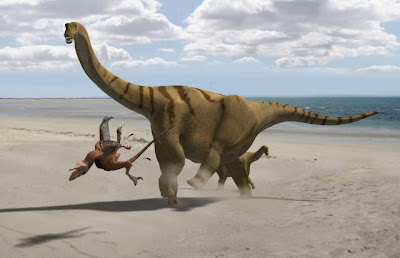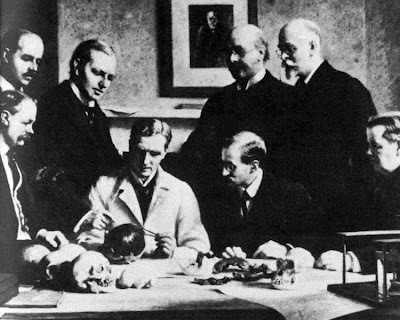Many of you are aware that Phil Currie and Eva Koppelhus were part of a team that spent Dec. and Jan. in Antarctica where they successfully completed the collection of the Cryolophosaurus holotype (after 20 years!), plus some other cool fossils.
The University of Alberta now has a slide show up here
Thanks to Clive Coy for the link. Please check out Clive's new blog on Roy Chapman Andrews HERE
Jumat, 25 Februari 2011
Brontomerus: Thunder-Thighs!
Brontomerus mcintoshi, a new sauropod dinosaur from the Lower Cretaceous Cedar Mountain Formation, Utah, USA. 2011. M.P. Taylor, et al. Acta Palaeontologica Polonica 56: 75-98.
Brontomerus mcintoshi is a newly discovered sauropod from the Early Cretaceous of North America. Brontomerus means "Thunder thighs" -- a name chosen because the peculiar shape of the hip bone shows that it would have had enormously powerful thigh muscles in life.
The quarry where the bones were found contains elements from at least two individuals, one of them three times as big as the other -- an adult and a juvenile. The life restoration shows a mother protecting her baby from a predator by using her powerful thigh muscles to deliver a devastating kick.
Notice how, in the reconstruction above, the hip bone projects a long way forward from the socket where it meets the leg: in life, muscles would have run down to the leg from the whole length of the hip bone, hence the name "Thunder thighs". link
Brontomerus mcintoshi is a newly discovered sauropod from the Early Cretaceous of North America. Brontomerus means "Thunder thighs" -- a name chosen because the peculiar shape of the hip bone shows that it would have had enormously powerful thigh muscles in life.
The quarry where the bones were found contains elements from at least two individuals, one of them three times as big as the other -- an adult and a juvenile. The life restoration shows a mother protecting her baby from a predator by using her powerful thigh muscles to deliver a devastating kick.
Notice how, in the reconstruction above, the hip bone projects a long way forward from the socket where it meets the leg: in life, muscles would have run down to the leg from the whole length of the hip bone, hence the name "Thunder thighs". link
I'm sure that using the term "thunder thighs" will generate a few hundred extras hits for the blog from the non-palaeo crowd. Parents: don't let your kids google that term without adult supervision!
Homoplasy
Homoplasy: From Detecting Pattern to Determining Process and Mechanism of Evolution. 2011. D. B. Wake, et al. Science 331: 1032-1035.
A review paper published this week suggests that studying examples of homoplasy can help scientists analyze the overwhelming deluge of genetic data and information that is currently being generated.
For example, studying situations where a derived trait surfaces in two lineages that lack a recent common ancestor, or situations where an ancestral trait was lost but then reappeared many generations later, may help scientists identify the processes and mechanisms of evolution.
The authors provide many fascinating examples of homoplasy, including different species of salamanders that independently, through evolution, increased their body-length by increasing the lengths of individual vertebrae. By contrast, most species grow longer by adding vertebrae through evolution.
The authors also explain how petals in flowers have evolved on six separate occasions in different plants. A particularly striking example of homoplasy cited by the authors is the evolution of eyes, which evolved many times in different groups of organisms--from invertebrates to mammals--all of which share an identical genetic code for their eyes.
These kinds of examples of genetic and developmental biology help scientists elucidate relationships between organisms, as well as develop a fuller picture of their evolutionary history. link
A review paper published this week suggests that studying examples of homoplasy can help scientists analyze the overwhelming deluge of genetic data and information that is currently being generated.
For example, studying situations where a derived trait surfaces in two lineages that lack a recent common ancestor, or situations where an ancestral trait was lost but then reappeared many generations later, may help scientists identify the processes and mechanisms of evolution.
The authors provide many fascinating examples of homoplasy, including different species of salamanders that independently, through evolution, increased their body-length by increasing the lengths of individual vertebrae. By contrast, most species grow longer by adding vertebrae through evolution.
The authors also explain how petals in flowers have evolved on six separate occasions in different plants. A particularly striking example of homoplasy cited by the authors is the evolution of eyes, which evolved many times in different groups of organisms--from invertebrates to mammals--all of which share an identical genetic code for their eyes.
These kinds of examples of genetic and developmental biology help scientists elucidate relationships between organisms, as well as develop a fuller picture of their evolutionary history. link
Sabtu, 19 Februari 2011
Born This Day: William Diller Matthew
Matthew (Feb. 19, 1871 – Sept. 24, 1930) was a superb mammalian paleontologist and important biogeographic theorist, and also G. G. Simpson's primary mentor. He published voluminiously on the fossil record of 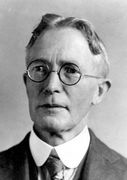 mammals and advocated a fully modern approach to taxonomy that emphasized tying scientific names to natural biological populations. His 1930 paper gives a clear statement of this position.
mammals and advocated a fully modern approach to taxonomy that emphasized tying scientific names to natural biological populations. His 1930 paper gives a clear statement of this position.
Matthew's key biogeographic theory was that waves of faunal migration repeatedly went from the northern continents southwards. This theory, which had obvious racial and political overtones, was justified by a "stabilist" view of paleogeography (i.e., that the continents had never moved from their modern positions), and by evidence from the relatively young fossil record of mammals, at the expense of other data that would have shown the more ancient interconnections among South America, Africa, India, and Australia. Remarkably, Matthew remained a Darwinian despite working for the autocratic orthogeneticist H. F. Osborn for three decades.
Info from HERE. Image from HERE.
 mammals and advocated a fully modern approach to taxonomy that emphasized tying scientific names to natural biological populations. His 1930 paper gives a clear statement of this position.
mammals and advocated a fully modern approach to taxonomy that emphasized tying scientific names to natural biological populations. His 1930 paper gives a clear statement of this position.Matthew's key biogeographic theory was that waves of faunal migration repeatedly went from the northern continents southwards. This theory, which had obvious racial and political overtones, was justified by a "stabilist" view of paleogeography (i.e., that the continents had never moved from their modern positions), and by evidence from the relatively young fossil record of mammals, at the expense of other data that would have shown the more ancient interconnections among South America, Africa, India, and Australia. Remarkably, Matthew remained a Darwinian despite working for the autocratic orthogeneticist H. F. Osborn for three decades.
Info from HERE. Image from HERE.
Born This Day: Sven Anders Hedin
Hedin (Feb. 19,1865 - Nov. 26, 1952) was a Swedish explorer and geographer, born in Stockholm, who led four multi-year expeditions into Central Asia between 1897 and 1935. Although not as well known as Roy Chapman Andrews his work in the  regions revealed a wealth of cultural, archaeological and palaeontological wonders.
regions revealed a wealth of cultural, archaeological and palaeontological wonders.
During his first major Asian expedition, he crossed the Pamirs, charted Lop Nor (Lake) in China, and finally arrived at Beijing. He then journeyed to Tibet by way of Mongolia, Siberia, and the Gobi Desert. Hedin explored Tibet and Xinjiang (Sinkiang), identified the sources of the Brahmaputra, Indus, and Sutlej rivers, and, in 1906, explored and named the Trans-Himalayas. In 1927 Hedin led an expedition of Chinese and Swedish scientists into Central Asia.
He wrote extensively about his adventures (e.g., Across the Gobi Desert, The Conquest of Tibet (1935), My Life as an Explorer (1926)) and they make for engaging and fascinating reading for anyone interested in the early days of exploring Central Asia. link
An excellent summary of Hedin’s life and expeditions into Central Asia can be found at the IDP News Archives image
 regions revealed a wealth of cultural, archaeological and palaeontological wonders.
regions revealed a wealth of cultural, archaeological and palaeontological wonders.During his first major Asian expedition, he crossed the Pamirs, charted Lop Nor (Lake) in China, and finally arrived at Beijing. He then journeyed to Tibet by way of Mongolia, Siberia, and the Gobi Desert. Hedin explored Tibet and Xinjiang (Sinkiang), identified the sources of the Brahmaputra, Indus, and Sutlej rivers, and, in 1906, explored and named the Trans-Himalayas. In 1927 Hedin led an expedition of Chinese and Swedish scientists into Central Asia.
He wrote extensively about his adventures (e.g., Across the Gobi Desert, The Conquest of Tibet (1935), My Life as an Explorer (1926)) and they make for engaging and fascinating reading for anyone interested in the early days of exploring Central Asia. link
An excellent summary of Hedin’s life and expeditions into Central Asia can be found at the IDP News Archives image
Born This Day: Sir Roderick Impey Murchison
Murchison (Feb. 19, 1792 - Oct. 22, 1871) was a Scottish geologist who first differentiated the Silurian strata in the geologic sequence of Early Paleozoic strata (408-540 million years old). He believed in fossils as primary criteria. In 1831, he began researching the previously geologically unknown graywacke rocks of the Lower Paleozoic, found underlying the Old Red Sandstone in parts of Wales, which culminated in his major work the Silurian System (1839).
Murchison named the Silurian after an ancient British tribe that inhabited South Wales. He established the Devonian working with Adam Sedgwick (1839). He named the Permian (1841) after the Perm province in Russia where he made a geological survey in 1840-45. link
Murchison named the Silurian after an ancient British tribe that inhabited South Wales. He established the Devonian working with Adam Sedgwick (1839). He named the Permian (1841) after the Perm province in Russia where he made a geological survey in 1840-45. link
Rabu, 16 Februari 2011
Born This Day: Jean-Baptiste-Julien d' Omalius d'Halloy
Feb. 16, 1783 - Jan. 15, 1875
d'Halloy was a Belgian geologist who was an early proponent of evolution and was acknowledged by Charles Darwin in his preface to ‘On The Origin of the Species’ for his opinions on the origin of new species through descent with modification.
He determined the stratigraphy of the Carboniferous and other rocks in Belgium and the Rhine provinces, and also made detailed studies of the Tertiary deposits of the Paris Basin. link
d'Halloy was a Belgian geologist who was an early proponent of evolution and was acknowledged by Charles Darwin in his preface to ‘On The Origin of the Species’ for his opinions on the origin of new species through descent with modification.
He determined the stratigraphy of the Carboniferous and other rocks in Belgium and the Rhine provinces, and also made detailed studies of the Tertiary deposits of the Paris Basin. link
Born This Day: Ernst Heinrich August Haeckel
Haeckel (Feb, 16, 1834 - Aug. 9, 1919) was a German zoologist and evolutionist who was a strong proponent of Darwinism and proposed new notions of the evolutionary descent of man. He coined many words commonly used by biologists today, such as phylum, phylogeny, and ecology.
He is noted for the book, The evolution of man: a popular exposition of the principal points of human ontogeny and phylogeny link
He is noted for the book, The evolution of man: a popular exposition of the principal points of human ontogeny and phylogeny link
Died This Day: Sandra Shaw
Although Sandra Shaw (May 27, 1913 – Feb. 16, 2000) had a short film career comprising a few, mostly uncredited film roles in 1933, her most famous appearance is that of the person plucked from her sleep from an unnamed hotel by King Kong, and than casually dropped to her death when he realizes that she is not Ann Darrow (Fay Wray). The year that Kong was released she married Gary Cooper.
Arbogast on Film blog has nice appreciation of Sandra Shaw’s few famous film moments.
Arbogast on Film blog has nice appreciation of Sandra Shaw’s few famous film moments.
Senin, 14 Februari 2011
Born This Day: Georg Christian Füchsel
Georg Christian Füchsel (Feb. 14, 1722 - June, 20, 1773) was the originator of the idea of stratigraphic formations & one of the first to make recorded measurements of sections of stratified rock. His major work, "Historia terrae et maris, ex historia Thuringiae, per montium descriptionem, eruta" (1861), contains the general principles of historical geology. From Today in Science History.
Selasa, 08 Februari 2011
Mendel's 1st Paper Published & Ignored
In 1865, Gregor Mendel, who first discovered the laws of genetics, read his first scientific paper to the Brünn Society  for the study of Natural Sciences in Moravia (published 1866).
for the study of Natural Sciences in Moravia (published 1866).
He described his investigations with pea plants. Although he sent 40 reprints of his article to prominent biologists throughout Europe, including Darwin, only one was interested enough to reply.
Most of the reprints, including Darwin’s, were discovered later with the pages uncut, meaning they were never read.
Fortunately, 18 years after Mendel's death, three botanists in three different countries researching the laws of inheritance, in spring 1900, came to realize that Mendel had found them first. Mendel was finally acknowledged as a pioneer in the field which became known as genetics. Info from Today In Science History
Read the paper HERE.
 for the study of Natural Sciences in Moravia (published 1866).
for the study of Natural Sciences in Moravia (published 1866).He described his investigations with pea plants. Although he sent 40 reprints of his article to prominent biologists throughout Europe, including Darwin, only one was interested enough to reply.
Most of the reprints, including Darwin’s, were discovered later with the pages uncut, meaning they were never read.
Fortunately, 18 years after Mendel's death, three botanists in three different countries researching the laws of inheritance, in spring 1900, came to realize that Mendel had found them first. Mendel was finally acknowledged as a pioneer in the field which became known as genetics. Info from Today In Science History
Read the paper HERE.
Senin, 07 Februari 2011
Born This Day: Godfrey Harold Hardy
Hardy (Feb. 7, 1877 – Dec. 1, 1947) was an English mathematician known for his work in number theory and mathematical analysis. Although Hardy considered himself a pure mathematician, he nevertheless worked in applied mathematics when he formulated a law that describes how proportions of dominant and recessive genetic traits will propagate in a large population (1908). Hardy considered it unimportant but it has proved of major importance in blood group distribution. As it was also independently discovered by Weinberg, it is known as the Hardy-Weinberg principle.
The Hardy-Weinberg equation
The Hardy-Weinberg equation
Minggu, 06 Februari 2011
Born This Day: Mary Leakey
From the Minnesota State University site:
Mary Douglas Nicol Leakey (Feb. 6, 1913 – Dec. 9, 1996) was in London, England. She meet her future husband, Louis Leakey, when he asked her to illustrate his book, 'Adam’s Ancestors'. Mary and Louis spent from 1935 to 1959 at Olduvai Gorge in the Serengeti Plains of northern Tanzania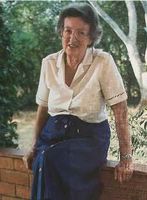 where they worked to reconstruct many Stone Age cultures dating as far back as 100,000 to two million years ago. They documented stone tools from primitive stone-chopping instruments to multi-purpose hand axes.
where they worked to reconstruct many Stone Age cultures dating as far back as 100,000 to two million years ago. They documented stone tools from primitive stone-chopping instruments to multi-purpose hand axes.
In October of 1947, while on Rusinga Island, Mary unearthed a Proconsul africanus skull, the first skull of a fossil ape ever to be found. It was dated to be twenty million years old. An Australopithecus boisei skull was uncovered in 1959. Not long afterwards, a less robust Homo habilis was found. In 1965 the duo uncovered a Homo erectus cranium.
After her husband died in 1972, Mary continued her work at Olduvai and Laetoli. She discovered Homo fossils at Laetoli which were more than 3.75 million years old, fifteen new species and one new genus. From 1978-81 Mary and her staff worked to uncover the Laetoli hominid footprint trail which was left in volcanic ashes 3.6 million years ago.
Image from HERE.
Mary Douglas Nicol Leakey (Feb. 6, 1913 – Dec. 9, 1996) was in London, England. She meet her future husband, Louis Leakey, when he asked her to illustrate his book, 'Adam’s Ancestors'. Mary and Louis spent from 1935 to 1959 at Olduvai Gorge in the Serengeti Plains of northern Tanzania
 where they worked to reconstruct many Stone Age cultures dating as far back as 100,000 to two million years ago. They documented stone tools from primitive stone-chopping instruments to multi-purpose hand axes.
where they worked to reconstruct many Stone Age cultures dating as far back as 100,000 to two million years ago. They documented stone tools from primitive stone-chopping instruments to multi-purpose hand axes.In October of 1947, while on Rusinga Island, Mary unearthed a Proconsul africanus skull, the first skull of a fossil ape ever to be found. It was dated to be twenty million years old. An Australopithecus boisei skull was uncovered in 1959. Not long afterwards, a less robust Homo habilis was found. In 1965 the duo uncovered a Homo erectus cranium.
After her husband died in 1972, Mary continued her work at Olduvai and Laetoli. She discovered Homo fossils at Laetoli which were more than 3.75 million years old, fifteen new species and one new genus. From 1978-81 Mary and her staff worked to uncover the Laetoli hominid footprint trail which was left in volcanic ashes 3.6 million years ago.
Image from HERE.
Sabtu, 05 Februari 2011
Born This Day: Sir Arthur Keith
Keith (Born 5 Feb 1866; died 7 Jan 1955) was a Scottish anatomist and physical anthropologist who specialized in the study of fossil humans and who reconstructed early hominid forms, notably fossils from Europe and North Africa. After graduating from university (1888), he travelled as a physician on a gold mining trip to Siam. There, he dissected monkeys and became interested in racial types.
In 1892, he returned to Britain and studied anatomy. In 1915, he published The Antiquity of Man, an anatomical survey of all important human fossil remains, at which time he believed that moderns humans are as old as extinct forms of humans. In 1931, New Discoveries was published in which he admitted that modern humans probably arose from types already separate in the early Pleistocene. From Today In Science History
Born This Day: Alexandre Brongniart
Brongniart (Feb. 5, 1770 - Oct. 7, 1847) was a French mineralogist, geologist, and naturalist, who first arranged the geologic formations of the Tertiary Period  (from 66.4 to 1.6 million years ago) in chronological order and described them.
(from 66.4 to 1.6 million years ago) in chronological order and described them.
He made the first systematic study of trilobites that became important in determining the chronology of Paleozoic strata (from 540 to 245 million years ago).
He helped introduce the principle of geologic dating by the identification of distinctive fossils found in each stratum and noted that the Paris formations had been created under alternate freshwater and saltwater conditions. image. From Today In Science History
 (from 66.4 to 1.6 million years ago) in chronological order and described them.
(from 66.4 to 1.6 million years ago) in chronological order and described them. He made the first systematic study of trilobites that became important in determining the chronology of Paleozoic strata (from 540 to 245 million years ago).
He helped introduce the principle of geologic dating by the identification of distinctive fossils found in each stratum and noted that the Paris formations had been created under alternate freshwater and saltwater conditions. image. From Today In Science History
Jumat, 04 Februari 2011
Kamis, 03 Februari 2011
Born This Day: Gideon Mantell
Mantell (Feb. 3, 1790 – Nov. 10, 1852), a physician of Lewes in Sussex in southern England, had for years been collecting fossils in the sandstone of Tilgate forest,  and he had discovered bones belonging to three extinct species: a giant crocodile, a plesiosaur, and Buckland's Megalosaurus. But in 1822 he found several teeth that "possessed characters so remarkable" that they had to have come from a fourth and distinct species of Saurian. After consulting numerous experts, Mantell finally recognized that the teeth bore an uncanny resemblance to the teeth of the living iguana, except that they were twenty times larger.
and he had discovered bones belonging to three extinct species: a giant crocodile, a plesiosaur, and Buckland's Megalosaurus. But in 1822 he found several teeth that "possessed characters so remarkable" that they had to have come from a fourth and distinct species of Saurian. After consulting numerous experts, Mantell finally recognized that the teeth bore an uncanny resemblance to the teeth of the living iguana, except that they were twenty times larger. 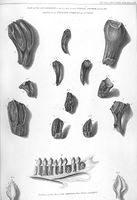
In this paper, the second published description of a dinosaur, he concluded that he had found the teeth of a giant lizard, which he named Iguanodon, or "Iguana-tooth."
Mantell illustrated his announcement with a single lithographed plate. Mantell included at the bottom of the plate a drawing of a recent iguana jaw, which is shown four times natural size, and for further comparison, he added views of the inner and outer surface of a single iguana tooth, "greatly magnified."
The traditional story that Mantell's wife found the first teeth in 1822, while the doctor was visiting a patient, appears, alas, to be unfounded.
Info and plate from HERE.
 and he had discovered bones belonging to three extinct species: a giant crocodile, a plesiosaur, and Buckland's Megalosaurus. But in 1822 he found several teeth that "possessed characters so remarkable" that they had to have come from a fourth and distinct species of Saurian. After consulting numerous experts, Mantell finally recognized that the teeth bore an uncanny resemblance to the teeth of the living iguana, except that they were twenty times larger.
and he had discovered bones belonging to three extinct species: a giant crocodile, a plesiosaur, and Buckland's Megalosaurus. But in 1822 he found several teeth that "possessed characters so remarkable" that they had to have come from a fourth and distinct species of Saurian. After consulting numerous experts, Mantell finally recognized that the teeth bore an uncanny resemblance to the teeth of the living iguana, except that they were twenty times larger. 
In this paper, the second published description of a dinosaur, he concluded that he had found the teeth of a giant lizard, which he named Iguanodon, or "Iguana-tooth."
Mantell illustrated his announcement with a single lithographed plate. Mantell included at the bottom of the plate a drawing of a recent iguana jaw, which is shown four times natural size, and for further comparison, he added views of the inner and outer surface of a single iguana tooth, "greatly magnified."
The traditional story that Mantell's wife found the first teeth in 1822, while the doctor was visiting a patient, appears, alas, to be unfounded.
Info and plate from HERE.
Died This Day: Ernst Mayr
Any student of biology, or anyone with an interest in the natural world, will be familiar with Ernst Mayr who passed away on February 3rd, 2005, in Bedford, Mass. Born in Kempton, Germany he joined the American Museum of Natural History as a curator in 1931. In 1953 he left the museum to work at Harvard University where he stayed until his retirement in 1975.
While working on the problem of speciation in the birds of New Guinea, Mayr realized that the multitude of species and and subspecies that he saw could best be explained as being a snapshot of evolution in action. He suggested that new species could arise when the range of one species was fractured long enough for members in different parts of the range to evolve characters that would not allow individuals to reproduce when they were brought back together again. This lead to him developing the “biological species concept” in which species are defined as populations of interbreeding organisms rather than just a collection of characters. This idea, along with his theory of “allopatric speciation” was published in his book “Systematics and the Origin of the Species” (1942) and later contributed to the “Punctuated Equilibrium” theory of Niles Eldredge and Stephen Jay Gould.
Ernst Mayr was himself inspired by the work of geneticist Theodosius Dobzhansky on the fruit fly Drosophila melanogaster and his book “Genetics and the Origin of the Species” (1937). These two men, together with the paleontologist George Gaylord Simpson, combined the sciences of genetics, zoology and paleontology into what is now known as “the new synthesis” that provides the modern experimental underpinning to the concepts that Charles Darwin presented in his book, “On the Origin of the Species” .
For anyone interested in learning more about modern evolutionary theory I’d recommend Mayr’s recent book “What Evolution Is” (2002). It’s written in an engaging and readable format from the perspective of someone who’s thought about evolution all his life.
While working on the problem of speciation in the birds of New Guinea, Mayr realized that the multitude of species and and subspecies that he saw could best be explained as being a snapshot of evolution in action. He suggested that new species could arise when the range of one species was fractured long enough for members in different parts of the range to evolve characters that would not allow individuals to reproduce when they were brought back together again. This lead to him developing the “biological species concept” in which species are defined as populations of interbreeding organisms rather than just a collection of characters. This idea, along with his theory of “allopatric speciation” was published in his book “Systematics and the Origin of the Species” (1942) and later contributed to the “Punctuated Equilibrium” theory of Niles Eldredge and Stephen Jay Gould.
Ernst Mayr was himself inspired by the work of geneticist Theodosius Dobzhansky on the fruit fly Drosophila melanogaster and his book “Genetics and the Origin of the Species” (1937). These two men, together with the paleontologist George Gaylord Simpson, combined the sciences of genetics, zoology and paleontology into what is now known as “the new synthesis” that provides the modern experimental underpinning to the concepts that Charles Darwin presented in his book, “On the Origin of the Species” .
For anyone interested in learning more about modern evolutionary theory I’d recommend Mayr’s recent book “What Evolution Is” (2002). It’s written in an engaging and readable format from the perspective of someone who’s thought about evolution all his life.
This Day In History: 1st Australopithecus africanus Announced

On this day in 1925 Raymond Dart announced the find of the “Taung child”, Australopithecus africanus, in The Star newspaper of Johannesburg, South Africa. Mr. Dart with his students made the find in the Taung limestone works in the Harts Valley of Bechuanaland. link
Langganan:
Komentar (Atom)

